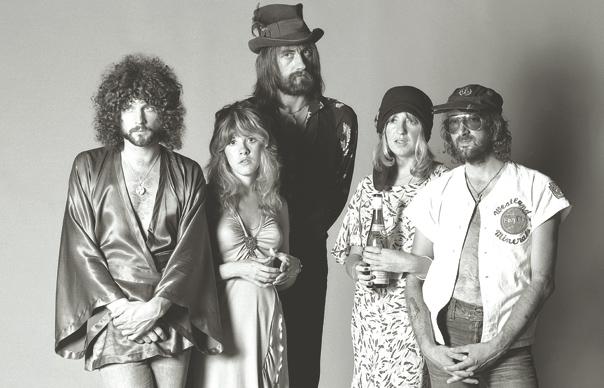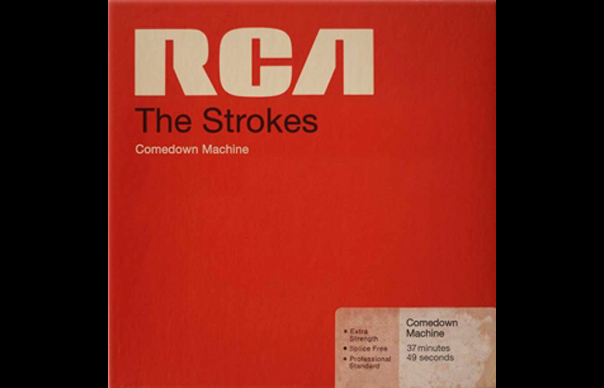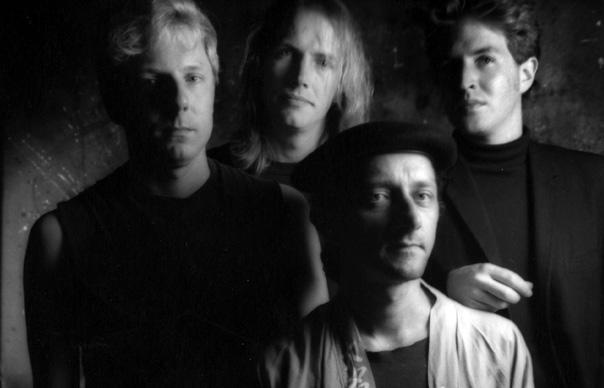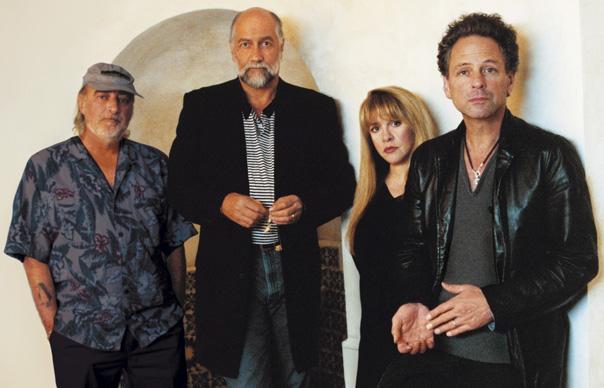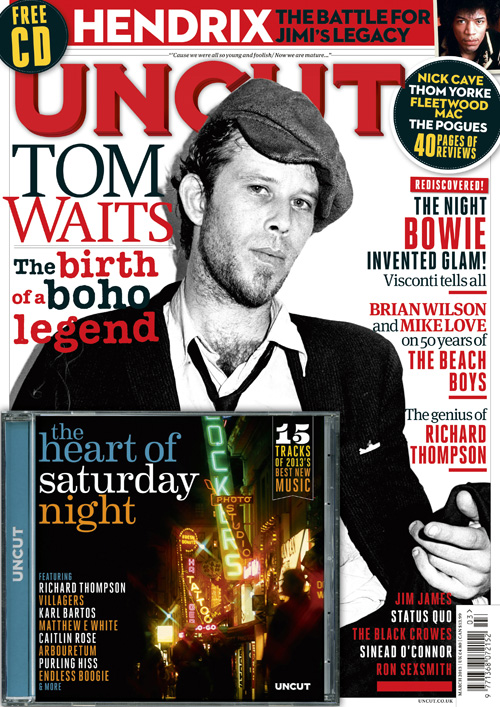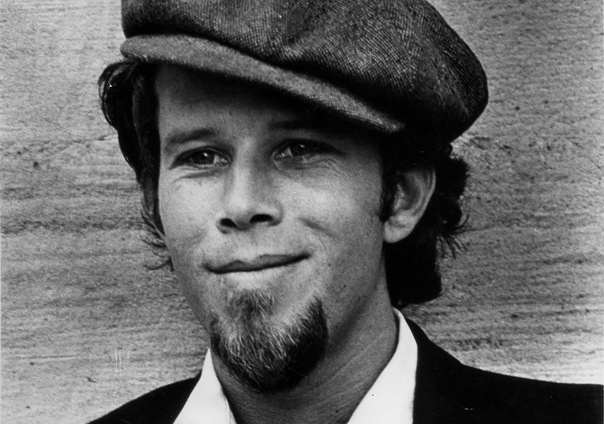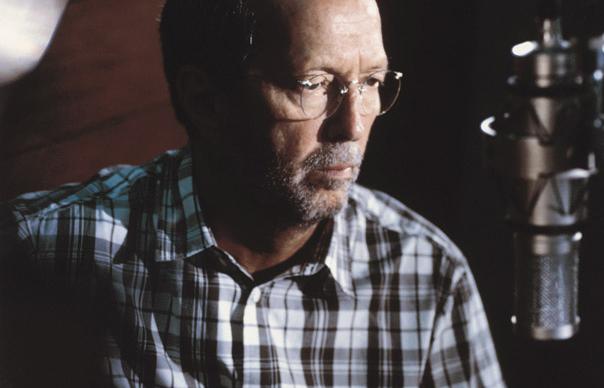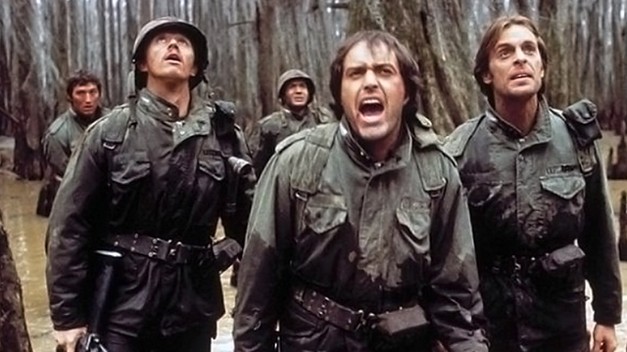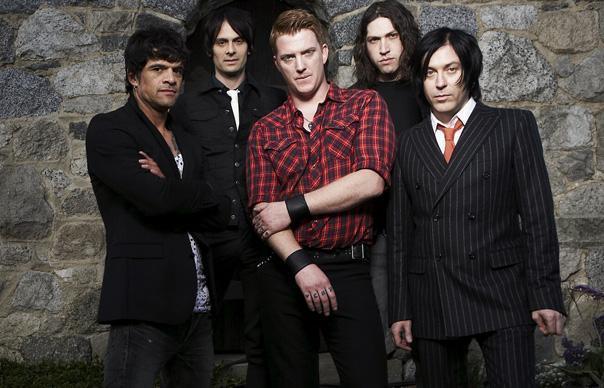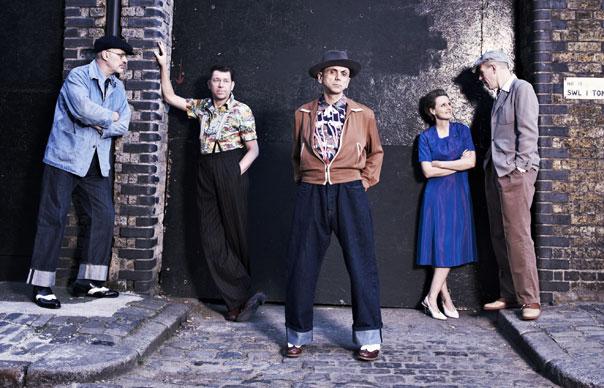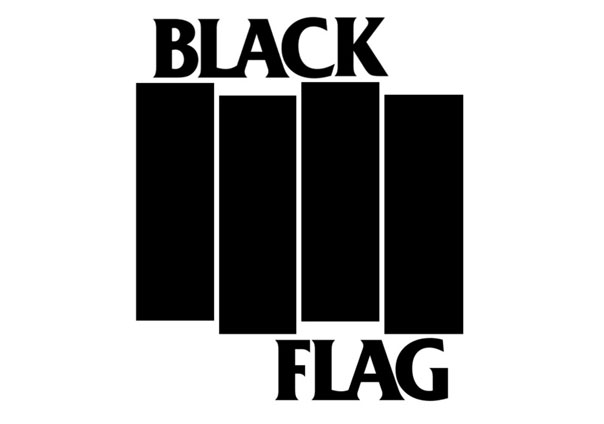In this archive feature from Uncut’s May 2003 issue (Take 72), rock’s greatest living soap opera tell the story of how they went to hell and back to bring the world some of the most popular, and most perfect, hard-centred easy listening music of all time. However, it nearly cost them their sanity. And their lives… Words: Nigel Williamson
_________________
When Mick Fleetwood rang Lindsey Buckingham on New Year’s Eve, 1974, and invited him to join Fleetwood Mac, the move seemed born of desperation.
Recently relocated to LA, the band’s star had waned since the glory days of Peter Green, and when guitarist, singer and composer Bob Welch had abruptly left what was the group’s ninth lineup in eight years, the future looked bleak indeed – particularly as Heroes Are Hard To Find, the band’s final album with Welch, had barely sold enough copies “to pay Warner Brothers’ electric light bill”, as Fleetwood puts it.
Across town, prospects for the Buckingham-Nicks duo looked equally unpromising. Born into a wealthy San Francisco family in October 1947, Lindsey Buckingham fell early under the influence of Elvis Presley’s guitarist Scotty Moore and folk groups such as The Kingston Trio and Peter, Paul And Mary. He taught himself guitar (he still doesn’t read music) and by 1968 found himself playing bass in a local Bay Area band called Fritz.
Buckingham in turn recommended to them a young singer called Stevie Nicks. Although she had grown up in Phoenix, Arizona, Nicks (born in May 1948) had first met Buckingham when she transferred to high school in San Francisco in 1966. Their ‘dream team’ introduction appeared to make their subsequent relationship inevitable. Buckingham had been playing “California Dreamin’” at a party and Nicks simply started singing with him. Two years later, when Fritz needed a singer, she was the first person he called.
Although they opened for Jimi Hendrix and Janis Joplin, a record deal failed to materialise, and it eventually became obvious they were going nowhere fast. By 1971, Fritz had split, and Buckingham and Nicks – by now lovers as well as musical soulmates – moved to LA. A record deal with Polydor resulted in the 1973 album Buckingham Nicks. But with no real marketing or promotion, it died a death. Nicks was reduced to waitressing at Clementine’s, a Beverly Hills singles bar, for $1.50 an hour, while Buckingham did a few sessions and lived on her money.
“I believed that Lindsey shouldn’t have to work, that he should just lay on the floor and practise his guitar and become more brilliant every day,” Nicks explains. “And as I watched him become more brilliant every day, I felt very gratified. I was totally devoted to making it happen for him. And when you really feel that way about somebody, it’s very easy to take your own personality and quiet it way down.”
But by late 1974, Nicks was “within weeks” of returning to her parents’ home in Phoenix, and contemplating a return to college.
“If we hadn’t joined Fleetwood Mac would Lindsey and I have carried on and made it?” she asks today. “I was really tired of having no money and being a waitress. It’s very possible that I would have gone back to school and Lindsey would have gone back to San Francisco.”
Mick Fleetwood, meanwhile, was searching for a new guitarist to replace the departed Welch, when he ran across Buckingham Nicks at Sound City Studios. He was impressed by the song “Frozen Love” from their Polydor album. But Fleetwood Mac already had a female singer in Christine McVie, so his initial invitation was merely to the guitarist.
“He was standing there grooving to this searing guitar solo and he needed a guitar player. That was as far as his thinking went. I had to explain we came as a duo. Stupid me, eh?” Buckingham jokes today.
Fleetwood was so convinced that Buckingham was his man that he swiftly agreed to take them both – although he promised Christine McVie that she had a veto if she disliked Nicks.
Initially, the guitarist had reservations about submerging his musical personality in an already established band – particularly as he had not been a fan of the Bob Welch-era Fleetwood Mac. Nicks swiftly reassured him.
“I said, ‘We can always quit. They’re going to pay us $200 each a week, so we can save some money and leave in six months with a little nest egg if it doesn’t work,’” she recalls today.
The ‘audition’ took place over dinner in a Mexican restaurant in LA. Christine McVie immediately took to the new girl, declaring Nicks to be “a bright, very humorous, very direct, tough little thing”. The 10th, and most enduring, of Fleetwood Mac’s multiple lineups was in place. Yet it was not necessarily the most stable.
What Buckingham and Nicks had failed to reveal to their new colleagues was that, although they came as a team, their relationship was already falling apart at the seams. “Lindsey and I were in total chaos a year before we met Fleetwood Mac,” Nicks tells Uncut almost 30 years on. “I had already moved out of our apartment a couple of times and then had to move back in because I couldn’t afford it. Our relationship was already in dire straits. But if we’d broken up within the first six months of Fleetwood Mac there would have been no record and we would have been in big trouble, so when we joined the band we took the decision to hang in there.”
_________________
Within three weeks of the Mexican restaurant meeting, Fleetwood Mac were in Sound City Studios in LA. The Buckingham-Nicks teaming brought a pile of songs with them and the difference they made to the sound was immediately evident.
Best of all was Nicks’ “Rhiannon”, a dreamy, bewitching song with an insistent guitar motif from Buckingham that swiftly came to define the new Fleetwood Mac. Not far behind were Nicks’ “Crystal” and “Landslide”, rescued and reworked from the duo’s Polydor album. Buckingham contributed “Monday Morning” and “I’m So Afraid”, while they collaborated on “World Turning”. Christine McVie also appeared inspired by the arrival of the newcomers, and contributed two of her most enduring compositions in “Say You Love Me” and “Over My Head”, as well as “Warm Ways” and “Sugar Daddy”.
The album was finished inside three months – astonishingly fast given the years they would spend labouring over future releases. Upon completion, the band repaired to Hawaii for a vacation.
When Fleetwood Mac was released in July 1975, its success was initially modest. But the band toured relentlessly. “There were no limousines and Christine slept on top of the amps in the back of the truck,” Nicks recalls. “We just played everywhere and we sold that record. We kicked that album in the ass.”
In September 1976, 15 months after its release, the album topped the US charts, having also produced three hit singles in “Over My Head”, “Rhiannon” and “Say You Love Me”.
By then, Fleetwood Mac had already been back at work for six months, recording the follow-up at the Record Plant in Sausalito, a half-hour drive over the Golden Gate Bridge from downtown San Francisco.
But during the relentless touring of the previous year, the cracks in the Buckingham-Nicks relationship had grown to a volcanic fissure, and the McVies were also in the middle of divorce proceedings.
The ever-affable and gregarious Fleetwood attempted to hold the ring, adding the roles of guidance counsellor and social worker to that of band leader. “Everybody was pretty weirded out,” Christine McVie told Cameron Crowe in a landmark 1977 Rolling Stone cover story. “But somehow Mick was there, the figurehead – ‘We must carry on, let’s be mature about this, sort it out.’”
It was a typically brave attitude, for the drummer had problems of his own, with his marriage to Jenny Boyd disintegrating.
“By the time we got to Rumours, the emotional rollercoaster was in full motion and we were all in a ditch. Everybody knew everything about everybody and I was definitely piggy-in-the-middle,” Fleetwood recalls. “But my best friend was also having an affair with my wife and it was all weird and twisted. It was a total mess and that’s how we made the album.”
Fleetwood concedes that he had just one consolation denied to the other couples. “At least I was spared the in-house, up-front situation. I didn’t have to actually work with my ex-spouse.”
While it was left to Fleetwood to console a very unhappy John McVie, the two women, who might so easily have been rivals, developed a mutual support society.
“We’re totally different, at complete opposite ends of the personality spectrum,” Christine McVie told me in Detroit during the 1997 reunion tour. “The one thing we had in common, which bound us together, was a sense of humour through all the pain.”
Later on, neither were short of female company as hairdressers, wardrobe mistresses and make-up artists were added to the extravagant Fleetwood Mac touring circus. But initially they were two women alone in a man’s world. “We didn’t have anybody else,” Nicks says. “We had to end up being close because otherwise it was just hang out with the guys all the time. And because there was this chaos going on with me and Lindsey, the band gave me a friend in this woman and I could hang out with Christine.”
When they had first arrived in San Francisco at the beginning of the year-long process that was the recording of Rumours, the Record Plant provided a house for the band’s living accommodation. Nicks and Christine McVie spent only one night under the same roof as the band’s male members. “That house was like the riot house,” Nicks tells Uncut. “There were girls everywhere and everybody was completely drunk the whole time. Me and Chris decided we couldn’t be there. The next day we moved out and got two matching apartments next to each other.”
Some nights after they had left the studio, a stoned John McVie would come looking for Christine. “He’d be walking up and down the corridor, very upset, screaming her name, and she’d be hiding in my room,” Nicks recalls. The inside sleeve of Rumours symbolically shows Stevie and Christine embracing while the fatherly Fleetwood looks on.
Christine Perfect and John McVie first met at a Fleetwood Mac gig one night in early 1968. At the time, she admits she was more interested in Peter Green. “But John asked me if I wanted a drink and we sat down and had a few laughs before they went on stage. Then after the concert he came over and said, ‘Shall I take you out to dinner some time?’ I went, ‘Whoa, I thought you were engaged or something.’ He said, ‘Nah, it’s all over.’ I thought he was devastatingly attractive but it never occurred to me to look at him.”
They went out for a short time, before John disappeared off on Fleetwood Mac’s first US tour. “By this time I was really crazy about him,” Christine recalls. “But I didn’t really know what was happening with him.”
She, in turn, went off to Germany with Birmingham blues band Chicken Shack, for whom she was keyboardist/vocalist, and had a fling with “a crazy German DJ” who asked her to marry him. She turned him down and instead wrote John a long letter explaining her feelings for him.
When Fleetwood Mac returned from America, McVie proposed. They were married 10 days later and Christine announced in Melody Maker that she was retiring to become a housewife. She soon tired of washing the dishes and, a few months later, in August 1970, she took the fateful decision to join her old man in Fleetwood Mac following Peter Green’s departure.
“We were very happy for three years and then the strain of me being in the same band started to take its toll,” she says. “When you’re in the same band as somebody, you’re seeing them 24 hours a day and you start to see an awful lot of the bad side. There’s a lot of drinking and John is not the most pleasant of people when he’s drunk. Very belligerent. I was seeing more Hyde than Jekyll.”
Christine had already embarked on an affair with the band’s sound engineer, Martin Birch, in 1973. At the same time, the band’s guitarist, Bob Weston, was having an affair with Fleetwood’s wife Jenny. This complex web of relationships almost split the band, before Weston was sacked and the McVies agreed to give it another chance. But this merely delayed the inevitable, and they broke up for good in the middle of the band’s 1975 US tour.
“I was aware of it being irresponsible,” Christine admitted to Cameron Crowe two years later. “But I had to do it for my sanity. It was either that or me ending up in a lunatic asylum. I still worry for him, more than I would ever dare tell him. I still have a lot of love for John. Let’s face it, as far as I’m concerned, it was him that stopped me loving him.
“He constantly tested what limits of endurance I would go to. He just went one step too far. If he knew that I cared and worried so much about him, I think he’d play on it.”
John McVie later wondered if their problems might not have happened if his wife hadn’t joined the band. But by the time they went into the studio to record Rumours, they weren’t speaking to each other.
“We literally didn’t talk, other than to say, ‘What key is this song in?’” Christine recalled. “We were as cold as ice to each other because John found it easier that way.”
A devastated John McVie began drinking and drugging more and more heavily.
“There’s no doubt about the fact that he hasn’t really been a happy man since I left him,” Christine said in 1977. “Sure, I could make him happy tomorrow and say, ‘Yeah, John, I’ll come back to you.’ Then I would be miserable. I’m not that unselfish.”
Even 20 years later, McVie still appeared to be carrying a torch for her. One night during the 1997 tour we all got drunk together in the hotel bar after a gig and he decided to address the entire room on the subject.
“She’s a lovely, lovely lady, my ex-wife, even though she told me to fuck off,” he bellowed at bemused fellow guests before he struggled to his feet and knocked over an entire table of drinks.
When sober, he is more philosophical. “You’ve got the pressure of being on the road and living with each other and seeing each other at their worst,” he told me the morning after the night before. “Chris saw me at my worst one time too many. I drink too much and when I’ve drunk too much, a personality comes out. It’s not very pleasant to be around. And bless her heart, Chris said, ‘I don’t want to be around this person.’ It was awful. You’re told by someone you adore and love that they don’t want you in their life any more.”
To make matters worse for McVie, his wife had taken up with the band’s lighting director, Curry Grant, whose presence around the band caused intense friction. “Wherever John was, he couldn’t be,” recalls Christine. “There were some very delicate moments.”
John, meanwhile, took what comfort he could from the groupies back at the band house provided by the Record Plant, and described by Fleetwood as “like a bordello with blacked-out rooms, thick shag carpets, deprivation tanks and a very liberal sprinkling of assorted drugs.”
_________________
Lindsey Buckingham and Stevie Nicks were at least talking – or, rather, ranting and raving at each other. At one point, the highly strung Buckingham thought of quitting.
“In the middle of it all, one day Lindsey said, ‘I don’t know whether I can handle this.’ He was not a happy camper,” recalls Mick Fleetwood. “I gave him a pep talk, saying, ‘This whole thing is a compromise. That’s what a band is about. But if it’s an unhealthy one for you, then you don’t have to be here.’ From then on he was really focused on making the record.”
For Nicks, there were no second thoughts. “Really, each one of us was too proud and way too stubborn to walk away from it,” she recalls. “I wasn’t going to leave. Lindsey wasn’t going to leave. What would we have done – sat around in LA and tried to start new bands? It was just ‘grit your teeth and bear it.’”
There were also problems between Buckingham and John McVie, the two jilted partners who found no comfort in each other’s company, as their womenfolk had done.
“I came in as the new kid on the block but I was also the kid with the ideas and so John and I used to butt heads quite a bit,” Buckingham recalls. “It took me a long time to appreciate his approach.”
On one occasion, McVie hurled a glass of vodka in the guitarist’s face. “About the only people in the band who haven’t had an affair are me and Lindsey,” he later grimly joked.
Instead of quitting, Nicks, Buckingham and Christine McVie began writing songs to each other, like pages from their respective diaries. You had to feel rather sorry for John. As Mick Fleetwood observes, “They were all talking to each other in songs and, because he doesn’t sing, he couldn’t talk back.” For Nicks, Buckingham wrote the album’s opener, “Second Hand News” (“One thing I think you should know/I ain’t gonna miss you when you go”). Nicks responded immediately with “Dreams” (“Now here you go again, you say you want your freedom”).
Then Buckingham takes up the conversation again. First in “Never Going Back Again” (“Been down one time/Been down two times/I’m never going back again”). Then even more forcefully in “Go Your Own Way” (“Loving you isn’t the right thing to do”), before Nicks responds once more with “I Don’t Want To Know” (“I don’t want to stand between you and love, honey/I just want you to feel fine”).
For John McVie, Christine penned “Don’t Stop”, a warm-hearted but still painful message to him that he would one day begin to feel better. However, he must have been less than thrilled to play bass on “You Make Loving Fun”, written by his estranged wife for the new man in her life, Curry Grant. She wrote “Oh Daddy” for Mick Fleetwood, separated from Jenny Boyd, the mother of his two children. “The Chain”, credited to the entire band, was apparently about all of them and the tangled web they had woven.
The album closes prophetically with Nicks’ cocaine anthem, “Gold Dust Woman”. “At that time, everybody around me was doing it,” she says. “Lindsey and I wonder if we hadn’t moved to LA would we ever have got into drugs? Drug-taking was methodical when we got to LA. It was, ‘Here, try this.’ Everybody was so willing to give you stuff and tell you you’d like it. ‘Gold Dust Woman’ was about how we all love the ritual of it, the little bottle, the diamond-studded spoons, the fabulous velvet bags. For me, it fitted right into the incense and candles and that stuff. And I really imagined that it could overtake everything, never thinking in a million years that it would overtake me.”
According to Buckingham, the drugs went with the territory. “It was anything goes and if you were making records you had to function on a certain level and we all did our share. It was music through chemistry.”
And although the drugs may have slowed down the process of recording, they played their part in heightening the band’s creativity.
“We weren’t just singing to each other but screaming and everything was enlarged by the intake of illegal substances,” Christine McVie admitted to me over a bottle of red wine in her hotel suite one night during the 1997 reunion tour.
Nicks – although she is today militantly anti-drugs and threatens to shop anyone around the band whom she catches – concedes the point: “We were in the worst shape. But it was helping us make the best music.”
Throughout the Rumours sessions, a black velvet bag of cocaine held pride of place under the mixing desk. Every so often, one or other member of the band would demand another hit. One day, engineer Ken Caillat substituted a dummy bag full of talcum powder. When it was next called for, he tipped the bag upside down and emptied the contents all over the floor. McVie and Fleetwood were about to kill him when the laughter of producer Richard Dashut, seated alongside Caillat, made them realise they’d been hoaxed.
But such lighter moments were few and far between. It took a year to make the album – “the most intense year of my life”, Lindsey Buckingham would later claim. “Trauma,” said Christine McVie. “Trau-ma.”
Yet even when they thought they’d finished, the drama wasn’t over. Having spent a year making the album, the master tapes had been dragged across the machine heads a thousand times. In those pre-digital days, this had led to a marked degradation of the sound quality, particularly at the upper end of the register, and the band had to go back into the studio in LA to redub.
Initially, the group appeared oblivious to the power of what they had gone and done. Buckingham wasn’t convinced that they had a hit on their hands at all. “I was worried that side two had no continuity,” he says. “I thought we’d done the best we could but the album was trailing off and lacked that extra song we needed. I really wasn’t aware of the compelling drama it had and I remember certain people being very negative about Rumours. We’re all so insecure and I really didn’t know.”
Christine McVie, at least in part, concurred in 1997 when she told this writer: “It was John who suggested the title Rumours because we were all writing journals and diaries about each other,” she says. “But we didn’t quite realise that until all the songs were strung together. Then we knew we had something pretty powerful, to a point that transcended everybody’s misery and depression. I think we knew that if we’d all been getting on like a house on fire, the songs wouldn’t have been nearly as good.”
Indeed. Has melodic MOR soft-rock ever surged with such emotional discharge and human electricity? Has such a highly polished veneer ever been so dramatically juxtaposed with such a scalding cauldron of simmering tensions and seething passions? Buckingham recalls them all sitting in the same booth, harmonising on each other’s songs and looking into each other’s eyes with emotions raging uncontrollably.
“You can look at Rumours and say, ‘Well, the album is bright and it’s clean and it’s sunny,’” Buckingham says. “But everything underneath is so dark and murky. What was going on between us created a resonance that goes beyond the music itself. You had these dialogues shooting back and forth about what was going down between us and we were chronicling every nuance of it. We had to play the hand out and people found it riveting. It wasn’t a press creation. It was all true and we couldn’t suppress it. The built-in drama cannot be underplayed as a springboard to that album’s success.”
Nicks puts it even more succinctly. “If you took out all the bad stuff in the band, the songs wouldn’t have happened. There simply wouldn’t have been a Rumours if everything had been fabulous.”
But if it seems miraculous that they managed to stay intact and functioning during the recording of the album, once Rumours started flying, the group found itself bound together by a force far stronger than any emotional dysfunction. Commerce.
“The band was at the pinnacle of its career and we had a responsibility not to break that up for anything as trivial as a divorce,” as Christine was later to joke.
Released in February 1977, Rumours topped the US album charts for six months. It was punk’s ‘year zero’. But that didn’t prevent Rumours topping the charts in Britain, where it remained in the Top 100 for the next eight years. The record sold 10 million in its first year and at its height in America was going platinum (one million sales) every 30 days.
Rumours also produced four US Top 10 singles in “Dreams”, “You Make Loving Fun”, “Go Your Own Way” and “Don’t Stop”, and the album ultimately went on to sell 25 million copies.
_________________
Upon its release, Fleetwood Mac embarked on an eight-month US tour that became a debauched, cocaine-and-champagne-fuelled odyssey across the continent, which cemented the band’s legendary reputation for excess. And the heady cocktail of success, drugs and more money than they knew how to spend left little space for reflection or time to slow down.
Christine McVie bought Anthony Newley’s old mansion in Coldwater Canyon and promptly installed her own English pub and a sculpture studio (in her youth she had briefly attended Birmingham Art College). Outside were parked a pair of matching Mercedes-Benz cars with license plates named after her pair of Lhasa Apsos. She also dumped lighting director Curry Grant for Beach Boy Dennis Wilson, who she claimed “awakened things in me I’d been scared to experience and made me feel the extremes of every emotion”.
Fleetwood bought a cliff-top house in Malibu and a fleet of vintage sports cars. Buckingham – who seemed the least impressed by the trappings of celebrity and money – bought a fine LA home which he shared with Rumours producer Richard Dashut, while John McVie divided his time between a 41-foot schooner moored at Marina del Rey and a home in Beverly Hills.
Nicks purchased a large, mock-Tudor home above Sunset Boulevard, referred to as “Fantasy Land”, and a home in Phoenix, which is still her base. None of the band was reticent about flashing their cash. But she bought into the rich-and-famous lifestyle more enthusiastically than anyone, having been taught to spend money, she claims, during her affair with the notoriously ostentatious Don Henley.
“He was responsible and I blame him every day. The Eagles had it down,” she tells Uncut. “They had the Lear jets and the presidential suites long before we did and so I learnt from the best. And once you learn to live like that, there’s no going back. It’s like, ‘Get me a Lear jet. I need to go to LA. I don’t care if it costs $15,000. I need to go now.’”
Nicks also embarked on a relationship with Mick Fleetwood that further jeopardised the band’s already fragile stability. “Never in a million years could you have told me that would happen. That was the biggest surprise. But Mick is definitely one of my great, great loves,” she was still claiming years later. “But that really wasn’t good for anybody. Everybody was angry, because Mick was married to a wonderful girl and had two wonderful children. I was horrified. I loved these people. I loved his family. So it couldn’t possibly work out. And it didn’t. It just couldn’t.”
In an even more bizarre relationship, on January 29, 1983, Nicks married Kim Anderson, the widower of a school friend, Robyn (the subject of her song “Gypsy”), who suffered from leukaemia, and who died three days after giving birth by Caesarean section to a baby boy called Matthew. Within five months, Nicks had become stepmother to the child by marrying the father.
The rest of the band were appalled, and Christine McVie admits she even refused to buy the couple a wedding present. Their misgivings were well-directed. Within eight months the couple were divorced.
Touring for Fleetwood Mac by now meant private jets and all manner of preposterous demands. Hotels would be told to paint rooms pink and install grand pianos. White, like the one on the cover of Imagine, of course. If they couldn’t be manoeuvred through the door, they had to be winched through the windows.
Somewhere in the midst of the madness, the group managed to record further albums. Following Rumours was never going to be easy and the double album Tusk, released in November 1979, met with distinctly mixed reactions. Again it took over a year to record and cost a million dollars – an unprecedented amount of money at the time. The album boldly mixed radio-friendly pop songs from Nicks and Christine McVie with more experimental and non-commercial pieces from Buckingham, who dominated the sessions and was adamant the band should show more ambition than merely recording ‘Rumours Part II’.
“Coming off an album as successful as that, we were being asked to get on this treadmill of clichéd thought and hash out the same thing again,” recalls Buckingham. “Punk and new wave had kicked in during the meantime and, although I wasn’t directly influenced by that music, it gave me a kick in the pants in terms of having the courage to try to shake things up a little bit. I wanted something that had a little more depth.”
Many of the 20 tracks on the album were prepared by Buckingham, working alone at home. “That got me to more esoteric places than I could go in a group situation. Then I’d take the songs back to the studio, and having the band build on it was the basic premise for much of Tusk,” he recalls.
The title track employed a 112-piece marching band. And the excess was equally gargantuan on a non-musical level. “Recording Tusk was quite absurd,” Christine McVie later admitted. “The studio contract rider for refreshments was like a telephone directory. Exotic food delivered to the studio, crates of champagne. And it had to be the best, with no thought of what it cost. Stupid. Really stupid. Somebody once said that with the money we spent on champagne on one night, they could have made an entire album. And it’s probably true.”
Tusk failed to replicate the numbers Rumours had done and although it rose to No 2 in Britain, it only made No 18 in the far more lucrative US market. Ultimately, it went on to sell eight million copies. Impressive for a double album, but in comparison to 25 million, a relative failure.
Other band members were not slow to point the finger at Buckingham. “The rest of the band had a cynical view towards the way Tusk was made and the reasons why I thought it was important to move into new territory,” the guitarist recalls. “It wasn’t just negativity. There was open hostility. Then I got a certain amount of flak because it didn’t sell as many as Rumours. Mick would say to me, ‘Well, you went too far, you blew it.’ That hurt. And so it’s gratifying now to hear Mick tell anyone who asks that it’s his favourite Fleetwood Mac album.”
Indeed, the drummer had expressed this very opinion to me just an hour earlier, although he also added that he still feels it would have been better “condensed” into a single disc.
The initially disappointing sales of Tusk were boosted by a mammoth 113-date world tour, on which every date was recorded for a live album. Meant to be a ‘cheap’ option after the million dollars blown on Tusk, with typical excess, Live, released in November 1980, was eventually assembled from taping over 400 live shows.
When a battle-weary Fleetwood Mac ended the Tusk tour at the Hollywood Bowl in late 1980, they were physically and mentally drained and barely able to stand the sight of each other.
“I used to go onstage and drink a bottle of Dom Perignon, and drink one offstage afterwards,” Christine McVie later recalled. “It’s not the kind of party I’d like to go to now. There was a lot of booze being drunk and there was blood floating around in the alcohol, which doesn’t make for a stable environment.”
The band was put on hold as members recharged their depleted batteries. Nicks, Buckingham and Fleetwood all made solo albums. But when only the former was successful, accountants and record company executives were soon agitating for another Fleetwood Mac album, and the band reconvened to make Mirage. Released in 1982, it was an unsatisfactory album that lacked either the raw emotion of Rumours or the runaway ambition which Buckingham had injected into Tusk. It sounded like a record made for the sole and cynical purpose of sustaining the Fleetwood Mac brand.
“The most disappointing thing to me after Tusk was the politics in the band,” Buckingham admits today. “They said, ‘We’re not going to do that again.’ I felt dead in the water from that. On Mirage, I was treading water, saying, ‘Okay, whatever,’ and taking a passive role. For me, none of the albums after Tusk quite had it. I think we lost something after that.”
Christine McVie has no doubt what is was they had mislaid. “Mirage was an attempt to get back into the flow that Rumours had. But we missed a vital ingredient. That was the passion,” she confesses bluntly.
_________________
It would be five more years before the band would release another album – and, being Fleetwood Mac, there was plenty more trauma in the intervening years. For Fleetwood, they were the beginning of the ‘lost’ years, which stretched on into the ’90s.
“I wasn’t quite Keith Moon but I was working hard on getting there,” he says today. Along the way he went bankrupt and was relieved of his duties as band manager. Much of his money went up his nose on drugs, although he insists even more was lost on property deals that went wrong.
“It was a wild trip that didn’t stop for nine years,” he recalls. “I tried very hard to leave the planet and I nearly did. I don’t want to romanticise something that’s extremely dangerous. It was fun, but it was a bloody nightmare and I would never do it again. It became boring and sordid.”
But the real casualty was the far more fragile figure of Nicks, whose cocaine addiction was escalating desperately out of control. Her use had begun as much as a way of coping as a means of getting high. “I’d never felt so tired in my life,” she recalls. “When I joined the band, the rock’n’roll life was a shock to my system. It’s so intense and so heavy and being like Fleetwood Mac was like being in the Army. I was doing a lot of drugs just to get me through to the next thing. I don’t remember how much we did. But we spent an awful lot of money on it.”
Although the coke worked for a while, there was a high price to pay. “We never stopped, never took vacations. And with coke you can stay up way too late. You don’t sleep for three days,” she recalls today. “But then it backfired. That’s what I tell people. And the payback is a bitch. Nobody should go through what I went through. It’s not even that good. There was a little bit of fun. But it wasn’t fun enough to destroy your life. It creeps me out to talk about it even now.”
By 1986, she had hit rock bottom and checked into the Betty Ford Clinic, where Nicks shared a spartan cubicle with an elderly alcoholic woman. Tammy Wynette was a fellow patient.
“I knew I was going to die and I didn’t want to die. So I was on my way,” she tells Uncut. “I did my 28 days and I came out and I was brilliant. I was as strong as an ox and I felt great. I could feel myself starting to glow again and I was totally excited about my life. When I walked through those doors at Betty Ford and they searched me and took away all my stuff, it was like, ‘OK I’m never doing THAT again because I’m never coming back to a place like this.’”
She was true to her word. “I haven’t even seen cocaine since 1986. Nobody would ever take it out in front of me because they know I would call the police,” she says. Yet although she didn’t know it at the time, there was worse to come. Nobody around her believed she could stay clean and her friends collectively intervened to persuade her to visit a psychiatrist. Fatefully – and almost fatally – he prescribed a tranquilliser called Klonopin.
Nicks is still angry to this day about what happened. “I agreed to see this psychiatrist to make everybody happy,” she says. “But if I had made a wrong turning and got lost and not arrived at that psychiatrist’s office that day, the destiny of my life would have been so changed.”
Her account of the addiction which ensued is salutary and frightening. “He gave me two little blue pills. One at morning and one at night. Within a couple of months that turned into four little blue pills. Then it became 15 blue pills. He kept increasing my dose. I was in there every two weeks for an hour and he watched me grow heavier and the light went out in my eyes. If I started to run out, I would start to shake so hard people would stare at me. I thought I had Parkinson’s disease. I was sick and high and miserable and overweight. I knew I was going to die.”
Finally, one day in the early ’90s, she realised she could not go on. “I called up my manager and said come and get me and take me to a hospital because I’m not going to be alive in two weeks.”
She spent 47 days in the Daniel Freeman hospital in Marina del Rey and kicking a prescription tranquilliser proved far more unpleasant than kicking her cocaine habit. “My hair turned grey. My skin peeled off. I couldn’t sleep. I had a terrible headache. My body felt like it was burning,” she recalls. She cannot help an involuntary shudder as she tells the story.
Nicks survived. But she is understandably bitter. “These psychiatrists and the medical community are the worst drug dealers in the world,” she says. “These drugs will make you fat, ruin your life, make you miserable and destroy anything you want to do. And nobody tells you that.”
The blow that Klonopin dealt to Fleetwood Mac was also almost fatal. By the time the band reconvened to record 1987’s Tango In The Night, Nicks had already been addicted to the tranquilliser for a year and was in no fit state to make a record.
With Fleetwood’s drug abuse also rendering him largely hors de combat, it was left to Lindsey Buckingham to pull the album together. “We had to rise to the occasion,” he recalls today. “It was a very difficult record to make. Half the time Mick was falling asleep. We spent a year on the record but we only saw Stevie for a few weeks. I had to pull performances out of words and lines and make parts that sounded like her that weren’t her.”
Buckingham concedes that Nicks was “the most challenging to deal with”. But he excludes nobody from his strictures. “Everyone was at their worst, including myself. We’d made the progression from what could be seen as an acceptable or excusable amount of drug use to a situation where we had all hit the wall. I think of it as our darkest period.”
With Nicks managing just two songs and Christine McVie three, Buckingham valiantly contributed six compositions and was required, with some reluctance, to give up songs such as “Big Love”, “Caroline” and “Family Man”, all of which had already been completed for his projected third solo album. If he had not done so, he recognised there simply wouldn’t have been an album.
“The rest of us were totally devoid of any focus,” Fleetwood admits.
Thanks to Buckingham’s gargantuan efforts, the result was a more than acceptable return to form, the greatest adversity yet again bringing the best out of Fleetwood Mac. Yet there’s no doubt that Buckingham was deeply distressed by the whole experience, and particularly disturbed by the condition of his former girlfriend.
“The way people were conducting their lives made it difficult to get serious work done. Mick was pretty nuts then. We all were. In terms of substance abuse, that was the worst it got,” he recalls. “And Stevie was the worst she’s ever been. I didn’t recognise her. She wasn’t the person I had once known.”
All of this directly contributed to the showdown in August 1987 when Buckingham walked out of the band, seemingly for good. “When I was done with the record, I said, ‘Oh my God. That was the worst recording experience of my life.’ And compared to making an album, in my experience, going on the road will multiply the craziness by times five. I just wasn’t up for that. I needed to pull out of the machine and try to maintain a level of integrity for the work that wasn’t about the scale or the sales.”
_________________
To replace Buckingham, the band recruited not one but two guitarists in Rick Vito and Billy Burnette. The new six-piece lineup recorded 1990’s forgettable Behind The Mask before Nicks and McVie also left. Doggedly, the rhythm section of Fleetwood and McVie – who retain legal ownership of the band name – vowed to soldier on. The resulting album, 1995’s Time – with Bekka Bramlett, daughter of Delaney and Bonnie, and former Traffic man Dave Mason added to the lineup – was even less satisfying.
Yet the flame of the Rumours lineup refused to die. After Bill Clinton had adopted “Don’t Stop” as his presidential campaign song in 1992, Buckingham, Nicks and Christine McVie all rejoined Fleetwood and John McVie to perform at the new President’s inaugural ball. Five years later, on the 20th anniversary of Rumours, came a reunion tour and The Dance, a live album culled from an MTV special.
Although Christine McVie didn’t enjoy the touring rigmarole and announced that she had come to the end of the road, the rest of the band found that time had proved a great healer.
“Just the fact that we’d survived gave us something in common,” Buckingham says.
“Looking back, it’s like listening to war stories,” Mick Fleetwood jokes. “But you have to remember there were people yelling in pain with their legs shot away. There’s blood and guts and disagreements still to this day. But that’s what makes it mean a shit.”
Picture: Sam Emerson


